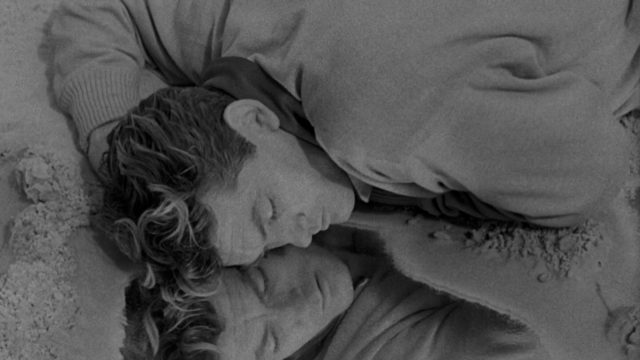Did you know that Jean Cocteau was lucky enough to have the most beautiful lovers in the world?
You don’t have to take my word for it; you just have to watch Orpheus. Cocteau had already shown his adoration for lead actor Jean Marais in his Beauty and the Beast, but Orpheus takes things to an entirely new level. Cocteau had already moved on from him by the time he shot Orpheus, but his new companion, painter and actor Edouard Dermithe, appears in the film as one of Orpheus’s poetic rivals. (“Weird flex, but okay,” as the kids say.) But the Princess who may or may not be Death*, Maria Casarès, is also inescapably beautiful, and Marais’ instant fascination with her is wholly believable, even in a story that runs on something closer to dream logic than simple cause and effect.
Orpheus is ambitious, poetic, a meditation on aging, loss and illusion, but the raw material Orpheus works with is beauty, whether it is in the stunning faces of his actors or the poetry that spills from a car radio. Cocteau was a fine artist and designer as well as a filmmaker, playwright, and poet, and it shows in the exquisite composition of every frame. (Cinematographer Nicolas Hayer also deserves full credit.) The special effects are so carefully done they sometimes don’t even register as magic.
Cocteau’s Beauty and the Beast was famous and influential enough to influence the Disney Renaissance. Orpheus is too idiosyncratic and personal for that. There are certainly images that a sharp viewer will recognize in other films (the car radio is an easy one), but the movie still feels stunningly unique and original.
Cocteau visited the Orpheus myth often in his career, and three times in his films: first in The Blood of a Poet and finally in Testament of Orpheus, completed only a few years before his death in 1963. The story of an artist so talented he captured the sympathy of a god — only to lose the prize he’d gained to a moment of doubt — clearly remained with him. He played Orpheus himself in Testament. (“I always advise people to copy a model,” he wrote. “It is by the impossibility of doing the same thing twice and by the new blood that is infused into the old frame that the poet is judged.”)
As far back as 1926, when Cocteau’s surrealist Orpheus adaptation hit the stage, Cocteau was playing with the imagery of mirrors, and the mirror plays a central role in Orpheus. It is through the mirror that Orpheus enters the underworld, and it is with a glance at his backseat mirror that he almost loses Eurydice permanently. It is through the mirror, Cocteau wrote, that we see ourselves age and grow closer to our own mortality. Orpheus (and Orpheus) is a reflection: of another, much older myth; of the many times Cocteau revisited that myth; of Cocteau himself, poet and artist, forever losing and gaining love, forever searching to best Death itself through the immortality of art.
The mirror reflects the passage of time, but the lens of the camera arrests it, if only for a moment or a few hours. Onscreen, Edouard Dermithe lives and dies, forever young and beautiful; onscreen, Jean Marais will never be anything less than the most beautiful man in the word.
* Cocteau insisted she was not, though most critics saw her as such; she’s as much Death as anything or anyone in this movie is who they appear to be. By the time of filming, Casarès herself was entangled in a sixteen-year affair with author and philosopher Albert Camus; she outlived him by more than thirty years.
Here’s the Criterion Collection page on Orpheus, with Cocteau’s own words and a video essay on the creative relationship between Marais and Cocteau.

